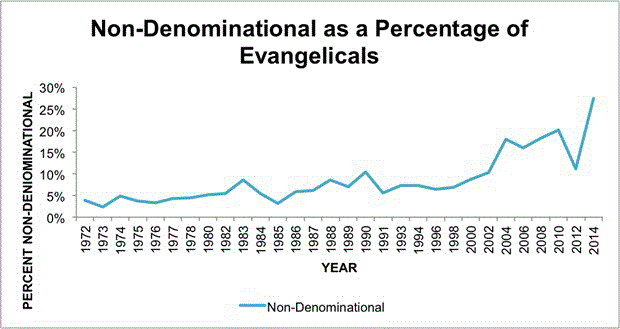Among American religious groups, Protestants comprise the largest, with 49% of the adult population, compared to Catholics with 23%, according to the latest Gallup poll conducted in December, 2017.1
Within the Protestant community, the fastest-growing group, by far, are “non-denominational” churches, which the Pew Religious Landscape Study of 2014 estimated as including from 4.9% to 6.5% of the U.S. population, depending on how you define the data.2 The largest Protestant denomination was the Southern Baptist Convention with 5.3% of the population, making “non-denominational” Protestant churches the de facto largest or second-largest denomination.
Data from the General Social Survey revealed that from the 1970s through 2014, the number of non-denominational Protestants grew at a much faster pace than any of the denominations—more than 400% over a forty-year period, shown in the following graph:3
In a 2015 story, religion reporter Ed Stetzer noted that “Many evangelicals are happy to talk about Jesus, but perhaps are reticent to talk about their denomination. Or they might not even know their church is affiliated with a larger group,” as the non-denominationals made up a “stunning” 25% of evangelical Protestants.4
Reviewing data from several studies, Scott Thumma of the Hartford Institute for Religion Research reported in 2012 that non-denominational churches were the second-largest religious group in 9 states and either the third- or fourth-largest in another 34 states:5
These congregations should be seen as a separate and distinctive religious reality. If we begin to think of them as not just individual aberrant outliers or lone isolated congregations but rather as a unique religious phenomenon – as a distinctive religious market segment – then we can begin to address the question of why they have become so popular in the past few decades.
Despite the consistent increase in evangelical Protestantism for decades, discussed in the recent post here, data from the past few years seem to show a growing movement away from religion. Whether this change points to a true shift in belief systems or just reluctance to identify with organizations is a topic for a future post. But separating from dominant institutions is a tried-and-true pastime in the U.S., making non-denominationalism a trend that is likely to continue and grow.
-
Frank Newport, “2017 Update on Americans and Religion,” Gallup.com, December 2017, http://news.gallup.com/poll/224642/2017-update-americans-religion.aspx↩
-
“Religious Landscape Study,” Pew Research Center’s Religion & Public Life Project, May 2015, http://www.pewforum.org/religious-landscape-study/↩
-
Ed Stetzer, “The Rapid Rise of Nondenominational Christianity: My Most Recent Piece at CNN,” Christianity Today, June 2015, http://www.christianitytoday.com/edstetzer/2015/june/rapid-rise-of-non-denominational-christianity-my-most-recen.html↩
-
ibid↩
-
Scott Thumma, “A Report on the 2010 National Profile of U.S. Nondenominational and Independent Churches,” Hartford Institute for Religion Research, May 2012, http://www.hartfordinstitute.org/cong/nondenominational-churches-national-profile-2010.html↩

